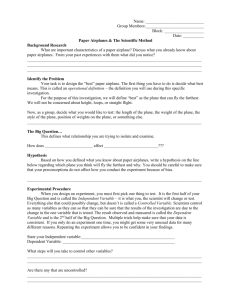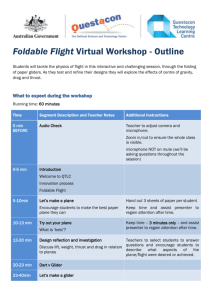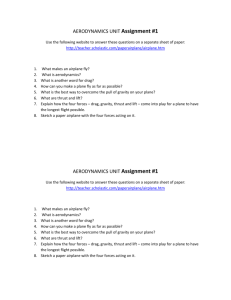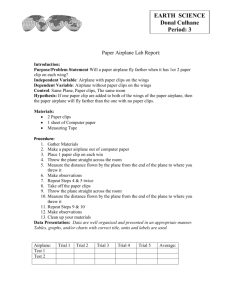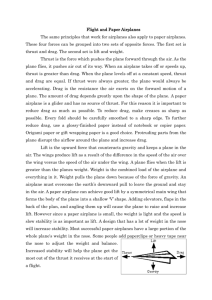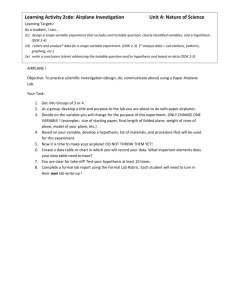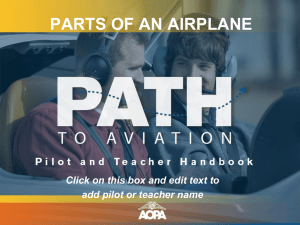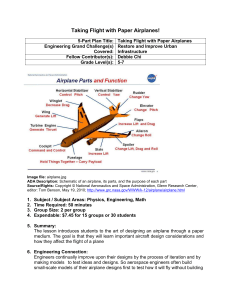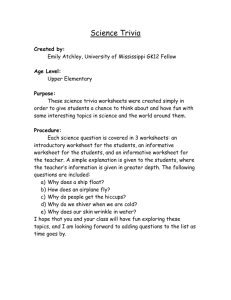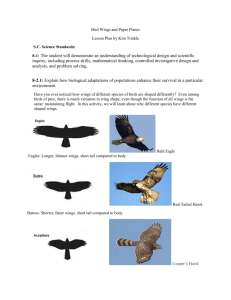how an airplane flies!
advertisement
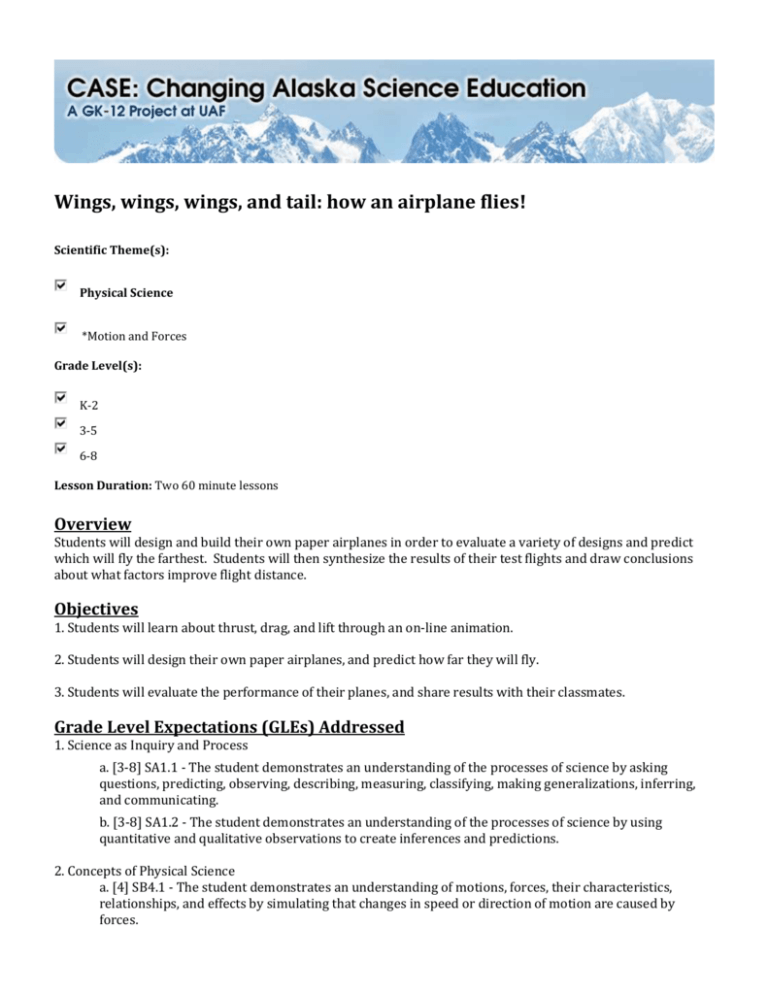
Wings, wings, wings, and tail: how an airplane flies! Scientific Theme(s): Physical Science *Motion and Forces Grade Level(s): K-2 3-5 6-8 Lesson Duration: Two 60 minute lessons Overview Students will design and build their own paper airplanes in order to evaluate a variety of designs and predict which will fly the farthest. Students will then synthesize the results of their test flights and draw conclusions about what factors improve flight distance. Objectives 1. Students will learn about thrust, drag, and lift through an on-line animation. 2. Students will design their own paper airplanes, and predict how far they will fly. 3. Students will evaluate the performance of their planes, and share results with their classmates. Grade Level Expectations (GLEs) Addressed 1. Science as Inquiry and Process a. [3-8] SA1.1 - The student demonstrates an understanding of the processes of science by asking questions, predicting, observing, describing, measuring, classifying, making generalizations, inferring, and communicating. b. [3-8] SA1.2 - The student demonstrates an understanding of the processes of science by using quantitative and qualitative observations to create inferences and predictions. 2. Concepts of Physical Science a. [4] SB4.1 - The student demonstrates an understanding of motions, forces, their characteristics, relationships, and effects by simulating that changes in speed or direction of motion are caused by forces. Required Background 1. Basic understanding of how a plane flies. The Smithsonian National Air and Space Museum website is a good resource for this. Vocabulary 1. Lift 2. Drag 3. Thrust Materials 1. Computer 2. Projector or document camera 3. Paper for making airplanes – min. 1 sheet/student 4. Pencils, pens, and colored markers 5. Tape measure 6. Masking tape 7. Clipboard for recording individual results 8. Butcher paper for compiling class results 9. Step stools or milk crates to use as launching pads 10. Student science notebooks Activity Preparation and Procedure Day 1: Introduction to planes and flight (60 min) 1. Hook (5 min.) - Teacher brandishes and throws paper airplane! Shocking! 2. Prior knowledge (5 min.) – Students are invited to discuss prior experiences with airplanes. 3. Thrust, drag, and lift (20 min.) a. Show students this funny and informative animation, from the Smithsonian National Air and Space Museum website: http://howthingsfly.si.edu/ b. Next, walk through the corresponding design-a-plane activity as a class, allowing students to choose different materials, engines, wing types, etc. (same website as animation). c. Review concepts with hand-motions: thrust (forward), drag (backward), and lift (upward). 4. Sample airplane designs (10 min.) a. Show students previously constructed paper airplanes. Include a variety of designs on different colored paper, with different features (e.g. wingtips bent up, nose bent down, etc.) b. Ask students to vote on which design they think will fly farthest. One student in favor of each plane should explain the reasoning behind his or her choice. 5. Sample plane trial (20 min.) a. Set up the launching pads and organize students in throwing each sample paper airplane three times, marking with tape where the nose lands each time. b. Measure and record the longest flight for each sample plane. Use straight line horizontal distance measured in meters from the center front edge of the launching pad. c. Compile the results on butcher paper and discuss them as a class. Were there any surprises? Day 2: Design and experiment with your own paper airplanes! 1. Student plane construction (15 min.) a. Demonstrate paper airplane construction: use a document camera to remind students of what they learned on Day 1. b. Give students time to construct their paper airplanes, adding their own modifications to the same basic form. Students should label planes with their names and, if time allows, decorate them. 2. Student plane flight trials (30 min.) a. Each student flies his or her plane three times, trying to use the same launching technique each time. b. Mark the position of the plane’s nose with tape after each landing. c. Measure and record the longest flight for each student’s plane. As before, measure straight line horizontal distance in meters from the center front edge of each launching pad. Ideally, this would be done one student at a time, but students may go in groups of three or four to speed things up. 3. Results! (15 min.) a. Tabulate—and reveal!—the results. b. Students discuss results and formulate potential explanations for what they observe. What factors helped or hindered the performance of the planes? c. Older students should record their results and responses in their science notebooks. Assessment 1. Given a drawing of a proposed paper airplane, ask students to label the force vectors and write a paragraph explaining how well they think the plane will fly, and why. Complementary Activities and Extension Ideas 1. Teach younger students a song! Wings, Wings, Wings, and Tail By Gabrielle Vance and Evangeline Hartley Tune: Row, Row, Row Your Boat Wings, wings, wings and tail Rudder, flaps, and nose (Flap arms like wings, then put hands behind your back to make a tail) (Put hands behind the head like antlers, then tucked in armpits, then touching the nose) The engine’s power, the pilot’s brain (Circle arms in front, then place hands on head) That’s how the plane goes! (Extend arms like wings and tilt from side to side to simulate flight) References Smithsonian National Air and Space Museum website: http://howthingsfly.si.edu/activities/forces-flight
